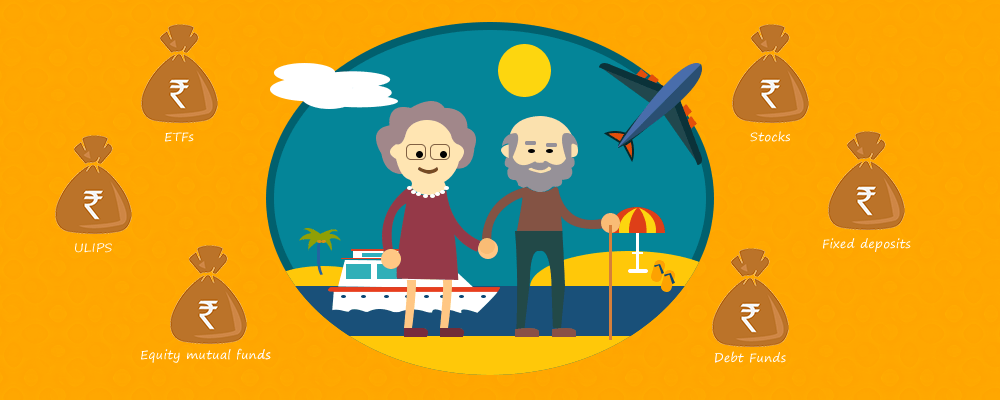How many times have you had those dreams of sitting on your front porch leisurely sipping a cup of coffee when you are old and grey? No harm in looking at your twilight years through rose-tinted glasses. Nevertheless, make sure you have invested smartly to live with dignity and grace for the rest of your life.
A stitch in time saves nine. With a plethora of investment strategies on offer in the market, it is pertinent that you examine each one of them carefully before choosing the one which best fits your financial requirements and needs. Draw up your plans now to know where you are headed.
Building a retirement corpus
Ideally, a smart investor would look for a combination of high inflation-adjusted returns and capital appreciation which will stand him in good stead.
Indians’ love for gold needs no introduction. India is the largest consumer of gold. The yellow metal is bought for almost all auspicious occasions and is traditionally considered a good investment. But will it prove to be a good investment for senior citizens as well?
The yellow metal is widely considered as a good hedge against inflation. Nevertheless, there is a view that gold is highly speculative in that it goes through peaks and valleys and, therefore, not an ideal hedge against inflation in the long-run.
Build a diversified portfolio
A diversified portfolio must include a combination of investments including gold. Investing in Gold commodity Exchange Traded Funds (ETFs) is widely considered a better option. In ETFs, investors expose their investments to the performance of gold, sans ownership of any gold products.
The debt:equity:gold ratio will determine how balanced your portfolio really is to provide adequately for your retired life without any hassles.
Most common investment options
| Investment | Degree of risk | Expected returns |
| PPF, EPF | Very low | Low to moderate |
| Fixed deposits | Very low | Low to moderate |
| Debt Funds | Low | Moderate |
| Stocks | High | High |
| ULIPS | High to moderate | Low to moderate |
| Equity mutual funds | High | High |
| ETFs | Moderate | High |
PPF is a government scheme which provides annual returns. The amount is usually locked up for 15 years. You can, however, extend the account and withdraw up to 50% of corpus after seven years. In EPF, the employee contributes 12% of his pay (basic plus dearness allowance), while his employer makes an equal contribution. The rate of return is decided by the central board of trustees of the fund every year. The money can either be withdrawn on retirement or at the time of quitting an organisation. Both PPF and EPF are deducted from income. The redemption amount, however, is not taxable.
2 . National pension scheme (NPS)
Under NPS, a government scheme, you have to contribute Rs 6,000 a year in a tier-I and tier-II account. While the money in the tier-I account cannot be withdrawn until your retirement, there are no limits on withdrawals from the tier-II account.
3. Unit Linked Insurance Plans (ULIPs)
ULIP encompasses both investment and insurance products. Although ULIPs are more expensive than mutual funds, owing to lack of insurance cover in the former, the investor can save on mortality charges. Investment in ULIP pension plan is eligible for tax deduction. The proceeds are tax-free.
4. POMIS (Post Office Monthly Income Scheme)
Under POMIS, retirees can invest their retirement benefit and earn high annual interest rates at 8.4% with monthly interest-payouts. The maturity period is 5 years while the minimum investment is Rs.1500.
5. SCSS (Senior Citizen Saving Scheme)
Under this scheme, senior citizens get tax benefits. SCSS offers high rates of interest at 9.20% p.a and allows for premature closure as well.
6. NSC (National Saving Certificate)
Government employees and salaried classes can buy National Savings Certificates (NSCs) every month for five years. There is no maximum limit for investment. Rates of interest offered are 8.60% and 8.80% under NSC VIII and IX issue respectively.
7. Fixed Deposit (FD)
For a period ranging from 15 days to 5 years and above, investors can earn a higher rate of interest in a fixed deposit compared to a regular savings account. Senior citizens avail of higher rates of interest. Deposits for 5 years and above get tax benefits.
8. Reverse Mortgage
Retirees can liquidate their assets during their retirement i.e, a borrower puts his property that he owns (no loan) up for sale for which the bank pays him for a fixed tenure.
9. Mutual Funds
A Systematic Investment Plan (SIP) in a diversified mutual fund portfolio encourages investors to save. The allocation pattern (large-cap, multi-cap, mid-cap, small cap funds and gold ETFs) is usually based on the investor’s risk appetite.
10. Stocks
Equity SIPs are a prudent investment choice in times of volatile stock market. SIPs allow small investments to be made over a period of time. It is affordable and provides the benefits of rupee cost averaging.
